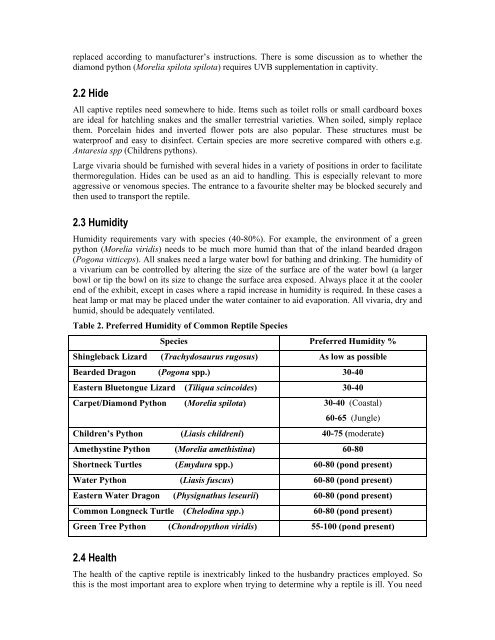Handling and Nursing Reptiles - Australian Veterinary Association
Handling and Nursing Reptiles - Australian Veterinary Association
Handling and Nursing Reptiles - Australian Veterinary Association
You also want an ePaper? Increase the reach of your titles
YUMPU automatically turns print PDFs into web optimized ePapers that Google loves.
eplaced according to manufacturer’s instructions. There is some discussion as to whether the<br />
diamond python (Morelia spilota spilota) requires UVB supplementation in captivity.<br />
2.2 Hide<br />
All captive reptiles need somewhere to hide. Items such as toilet rolls or small cardboard boxes<br />
are ideal for hatchling snakes <strong>and</strong> the smaller terrestrial varieties. When soiled, simply replace<br />
them. Porcelain hides <strong>and</strong> inverted flower pots are also popular. These structures must be<br />
waterproof <strong>and</strong> easy to disinfect. Certain species are more secretive compared with others e.g.<br />
Antaresia spp (Childrens pythons).<br />
Large vivaria should be furnished with several hides in a variety of positions in order to facilitate<br />
thermoregulation. Hides can be used as an aid to h<strong>and</strong>ling. This is especially relevant to more<br />
aggressive or venomous species. The entrance to a favourite shelter may be blocked securely <strong>and</strong><br />
then used to transport the reptile.<br />
2.3 Humidity<br />
Humidity requirements vary with species (40-80%). For example, the environment of a green<br />
python (Morelia viridis) needs to be much more humid than that of the inl<strong>and</strong> bearded dragon<br />
(Pogona vitticeps). All snakes need a large water bowl for bathing <strong>and</strong> drinking. The humidity of<br />
a vivarium can be controlled by altering the size of the surface are of the water bowl (a larger<br />
bowl or tip the bowl on its size to change the surface area exposed. Always place it at the cooler<br />
end of the exhibit, except in cases where a rapid increase in humidity is required. In these cases a<br />
heat lamp or mat may be placed under the water container to aid evaporation. All vivaria, dry <strong>and</strong><br />
humid, should be adequately ventilated.<br />
Table 2. Preferred Humidity of Common Reptile Species<br />
Species Preferred Humidity %<br />
Shingleback Lizard (Trachydosaurus rugosus) As low as possible<br />
Bearded Dragon (Pogona spp.) 30-40<br />
Eastern Bluetongue Lizard (Tiliqua scincoides) 30-40<br />
Carpet/Diamond Python (Morelia spilota) 30-40 (Coastal)<br />
60-65 (Jungle)<br />
Children’s Python (Liasis childreni) 40-75 (moderate)<br />
Amethystine Python (Morelia amethistina) 60-80<br />
Shortneck Turtles (Emydura spp.) 60-80 (pond present)<br />
Water Python (Liasis fuscus) 60-80 (pond present)<br />
Eastern Water Dragon (Physignathus leseurii) 60-80 (pond present)<br />
Common Longneck Turtle (Chelodina spp.) 60-80 (pond present)<br />
Green Tree Python (Chondropython viridis) 55-100 (pond present)<br />
2.4 Health<br />
The health of the captive reptile is inextricably linked to the husb<strong>and</strong>ry practices employed. So<br />
this is the most important area to explore when trying to determine why a reptile is ill. You need

















